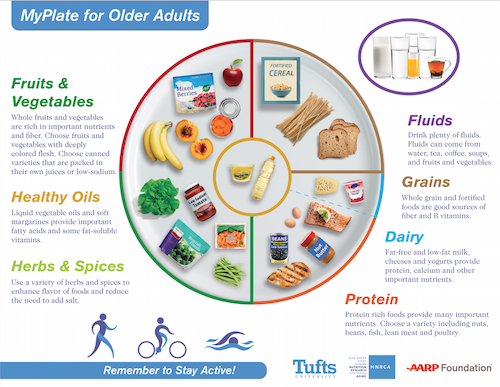
A new website and graphic about the nutritional needs of older adults were unveiled March 7 by nutrition scientists at Tufts University with support from the AARP Foundation.
The updated MyPlate for Older Adults information follows the framework of the 2015-2020 Dietary Guidelines for Americans released in January the U.S. Department of Health and Human Services and the U.S. Department of Agriculture.
“Shifting towards healthier food choices can improve symptoms or decrease risk for developing chronic diseases such as type 2 diabetes, hypertension and heart disease — all of which are more common in older than younger adults,” said Alice H. Lichtenstein, D.Sc., senior scientist and director of the Cardiovascular Nutrition Laboratory at the the U. S. Department of Agriculture Human Nutrition Research Center on Aging at the university. Lichtenstein served as vice chair on the 2015 Dietary Guidelines Advisory Committee.
The new icon depicts a colorful plate with images to encourage older Americans to follow a healthy eating pattern bolstered by physical activity. The plate is composed of approximately:
- 50% fruits and vegetables;
- 25% grains, many of which are whole grains; and
- 25% protein-rich foods such as nuts, beans, fish, lean meat, poultry, and fat-free and low-fat dairy products such as milk, cheeses and yogurts.
The new graphic also includes images of good sources of fluids, such as water, milk, tea, soup and coffee; heart-healthy fats such as vegetable oils and soft margarines; and herbs and spices to be used in place of salt to lower sodium intake. The graphic also reminds older Americans to stay active by walking, riding a bicycle, swimming or engaging in other activities to reduce the risk of disease and disability.
The 2015 Dietary Guidelines recommend that Americans:
- Follow a healthy eating pattern across their lifespan;
- Focus on the variety and amount of nutrient-dense food they consume;
- Reduce their intake of added sugars, saturated fats and sodium to allowed limits;
- Shift toward healthier food and beverage choices; and,
- Support healthy eating patterns for all.
The website offers information about physical activity, using spices to reduce sodium, shopping tips and recipes. Additionally, the website offers links to studies from researchers at the USDA HNRCA that are especially relevant for older adults.



